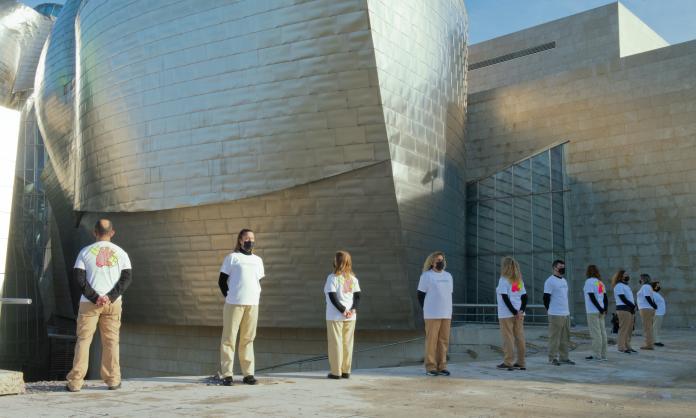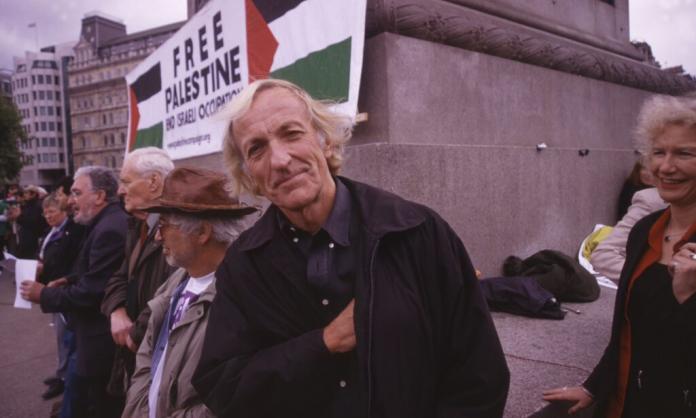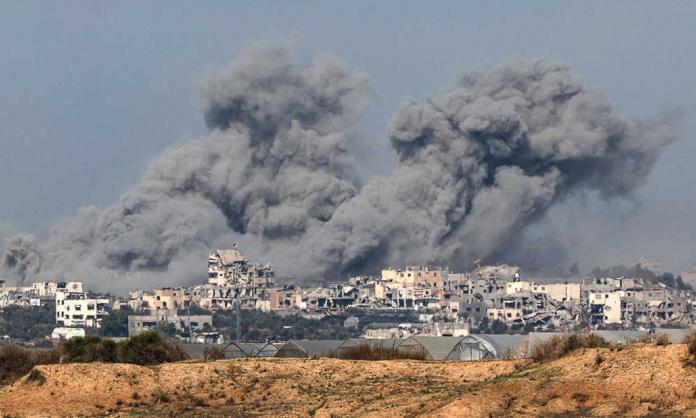The sculptural silver exterior of the Frank Gehry-designed Guggenheim Bilbao Museum is notable for its monumentality and architectural significance. For one hour last December it was also notable for the 12 members of museum cleaning staff standing silently at the top of the enormous staircase in front of the Museum’s entrance. Wearing t-shirts with the question “Is everyone’s work equally important?” printed on them, the workers were collaborating with artist Lorenzo Bussi and the Art Builders Group on a performance piece about their exploitation as employees of the Museum.
The protest-performance was part of a long-running dispute. Thirteen members of the cleaning team had been on strike since June 2021 over their paltry pay of as little as €5 an hour (equivalent to around $8), and working conditions which include hours that massively exceed those stated in their contracts.
Public disputes about labour rights in international museums have gained increasing coverage in the arts media over the last few years. The prominence of reporting on unionising efforts, staff pickets, and managerial backtracking suggests a modest shift in how these institutions are perceived publicly. Reports of overwork and underpayment are likely familiar to anyone who has ever held a gallery or museum job. But until recently, labour issues in major arts and cultural institutions have tended to be obscured by an image centred on their role in “educating and enlightening” the public.
To the extent that there has been serious political controversy, criticism and protest centred on such institutions, it has focused more on their capacity to reputation-raise and whitewash otherwise unsavoury images, rather than their labour practices. The cancelling of the National Gallery of Victoria’s contract with Wilson Security after artists and activists drew attention to the security firm’s role in detaining asylum seekers in offshore prisons is an example.
In 2019 the collective Decolonize This Place led a sustained campaign of protests, stunts and speak-outs in New York that resulted in Warren Kanders, the CEO of tear gas manufacturer Safariland, stepping down as vice chairman of the Whitney Museum board. In 2018 artist Nan Goldin founded Prescription Addiction Intervention Now (PAIN), which has since staged actions in major museums around the world in protest against museum donors the Sackler family and their company Purdue Pharma’s complicity in fuelling the American opioid epidemic for profit. Closer to home, in January artists and pro-Palestinian activists led a boycott campaign of the Sydney Festival for accepting a $20,000 grant from the Embassy of Israel to fund its programming.
The practice of “art-washing” is the key point of contention for activists and commentators in many of these instances. Indeed, the fact that the ruling class uses the progressive gloss gained via patronage of the arts as a means of doctoring its moral and political balance sheet is both unsurprising and appalling.
However, the takeaway here shouldn’t be that these galleries, museums or festivals would in fact be pure bastions of cultural inquiry and artistic achievement if only the big bad capitalists (or, as was the case with the Sydney Festival, state actors like Israel) kept their funding dollars to themselves. The role of these institutions as “image managers” for their donors is only one way in which they are enmeshed with the antihuman politics and policies of big business and the global elite.
Major cultural institutions are part of the global arts and cultural marketplace, and as such, just like all other institutions under capitalism, are themselves sites of class struggle. The wealth generated by these institutions—whether directly via the charging of entry fees for exhibitions, performances and so on, or indirectly through their role in maintaining the prestige associated with art and cultural products, and thus boosting their value as assets on the art market—is ultimately dependent on the daily exploitation of workers who hang the paintings, scan the tickets, write the catalogue copy, restore the artworks, staff the gift shops and sweep the floors.
As was the case with other industries like retail and hospitality, the disruption to the “business as usual” of art and culture caused by the COVID-19 pandemic served to highlight the fundamental inequality that structures the sector. Online arts magazine Hyperallergic reported, in July 2021, that while thousands of arts workers in America were furloughed during the pandemic, and museums cried poor and threatened to sell their collections, museum directors raked in an average annual salary of US$320,600.
Job insecurity has also intensified in some of the most hallowed of modern and contemporary art meccas. In April 2020 the Museum of Modern Art in New York disgracefully sacked its entire museum educator team, citing budget shortfalls. The Guggenheim New York furloughed 92 employees during the pandemic, and the New Museum’s union reported in August 2020 that every member of its bargaining committee had been laid off.
These circumstances have been met with resistance by workers on a number of fronts with pickets, open letters and public statements drawing attention to layoffs, wage theft, hostile contract negotiations and union-busting. As artist Jessalyn Aaland—author of Organizing Power: Unionizing Your Workplace for the Arts/Nonprofit Worker—says, “the pandemic is really the match lighting the tinder that’s been building up for years”.
Perhaps most significantly, unions have sprung up in institutions where previously there were none. Workers at major museums such as the Museum of Contemporary Art Los Angeles, the Philadelphia Museum of Art, the Museum of Fine Arts, Boston, and the Portland Museum of Art have all recently voted in favour of forming unions. This kind of collective action has long been absent or marginal in an industry where passion and ambition are frequently translated into free or cheap labour, and both hustling and suffering are characterised as virtues vital to one’s success.
The pandemic has revealed the prevalent narratives of endless upward mobility, individualism and exceptionalism to be a farce, and brought the class divide to the attention of many people for whom the fact of being an exploited worker has long been masked by abstract-sounding job titles and a sense of idealistic commitment to their work. As Dana Kopel wrote in her September 2021 article in The Baffler, “Against Artsploitation”, in the US at least, arts workers are increasingly rejecting “the toxic myth that ‘if you do what you love, you’ll never work a day in your life’”.
Though these public organising efforts have largely, to date, been limited to high profile institutions in the world’s cultural capitals, it’s a reckoning waiting to happen across the art and museum sector globally.
Following the cleaners’ protest, the Guggenheim Bilbao released a statement attempting to distance itself from the dispute raised by the workers. It claimed that, “regarding the strike by 13 workers out of the 18 who provide cleaning services at the Guggenheim Museum Bilbao, the Museum would like to clarify that this is part of a conflict that goes beyond the Museum itself, as it concerns a sectorial dispute—the office cleaning sector—in the entire province of Biscay that affects around 2,000 workers”.
Contrary to what the Guggenheim’s management seem to believe, however, this statement does not show the Museum’s innocence in the matter. It instead points to its complicity in the widespread practice of outsourcing labour—a practice that enables such institutions to wash their hands of any responsibility to the workers who run and maintain them. Elite museums and galleries, so the story goes, don’t deal in mundane, everyday matters like the pay and conditions of mere cleaners. Their concern is with the higher realm of art and culture.
Yet, in December, there were the Museum’s cleaners, standing on the steps outside the main entrance, making art—the subject of which was their oppression as workers in the Museum. No amount of PR-speak could conceal, in this context, the role of the Guggenheim as an active participant in, and proponent of, the thoroughly crass and material exploitation of workers for profit.
The Guggenheim’s management are right about one thing though: the conflict does go beyond the Museum itself. The problems faced by workers in the Guggenheim, just like those faced by the many thousands of other art and museum workers in similar institutions around the world, can’t be solved via small wins here or there. The system of capitalism, of which these institutions are part, depends on exploitation for its survival. To overcome this ultimately requires the coming together of workers across all industries in joint struggle against that system.
The more arts workers feel themselves to be part of that struggle, rather than buying into rhetoric about art and culture as existing in a world apart, the better.










